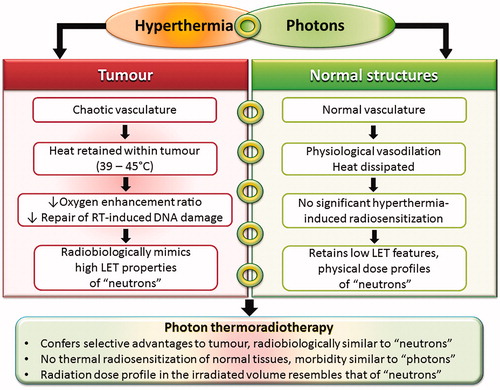Figures & data
Figure 1. Local hyperthermia (LTH) markedly influences survival of Ridgway osteogenic sarcoma cell lines. Cell survival curves following fractionated X-ray irradiation, making them steeper and reducing the shoulder. The curves almost assume the shape following fast neutron irradiation alone. The effect of LTH on cell curves with fast neutrons is minimal (Reprinted from Hahn et al. [Citation36] with permission, ©2019 Radiation Research Society).
![Figure 1. Local hyperthermia (LTH) markedly influences survival of Ridgway osteogenic sarcoma cell lines. Cell survival curves following fractionated X-ray irradiation, making them steeper and reducing the shoulder. The curves almost assume the shape following fast neutron irradiation alone. The effect of LTH on cell curves with fast neutrons is minimal (Reprinted from Hahn et al. [Citation36] with permission, ©2019 Radiation Research Society).](/cms/asset/b296c2fa-c247-4dec-8cea-6a32d5ac09e7/ihyt_a_1679895_f0001_b.jpg)
Figure 2. Hyperthermia with photon radiotherapy selectively confers the radiobiological advantages of high LET radiation (e.g. neutrons) to tumors. Normal tissues, with a heat sink effect, would not undergo thermal radiosensitization, thus retaining low LET characteristics with photons. The physical dose profile of photons is similar to that of neutrons in the irradiated volume.

Figure 3. Hyperthermia with photons and protons is thermoradiobiologically analogous to high LET radiation. The upper panel illustrates the selective advantages of photon beam thermoradiotherapy in tumors, analogous to high LET neutron irradiation. Normal tissues do not show any significant thermal sensitization and are irradiated with low LET photons. A selective advantage for tumors is expected to improve the therapeutic ratio. The lower panel depicts the rationale of combining proton therapy and hyperthermia to mimic 12C ion therapy. Lower panel has been modified and reprinted from Datta et al. [Citation13] with permission, ©2019 Francis & Taylor Group.
![Figure 3. Hyperthermia with photons and protons is thermoradiobiologically analogous to high LET radiation. The upper panel illustrates the selective advantages of photon beam thermoradiotherapy in tumors, analogous to high LET neutron irradiation. Normal tissues do not show any significant thermal sensitization and are irradiated with low LET photons. A selective advantage for tumors is expected to improve the therapeutic ratio. The lower panel depicts the rationale of combining proton therapy and hyperthermia to mimic 12C ion therapy. Lower panel has been modified and reprinted from Datta et al. [Citation13] with permission, ©2019 Francis & Taylor Group.](/cms/asset/99ff7a11-c838-492f-8f11-e5cdfef69f6c/ihyt_a_1679895_f0003_c.jpg)
